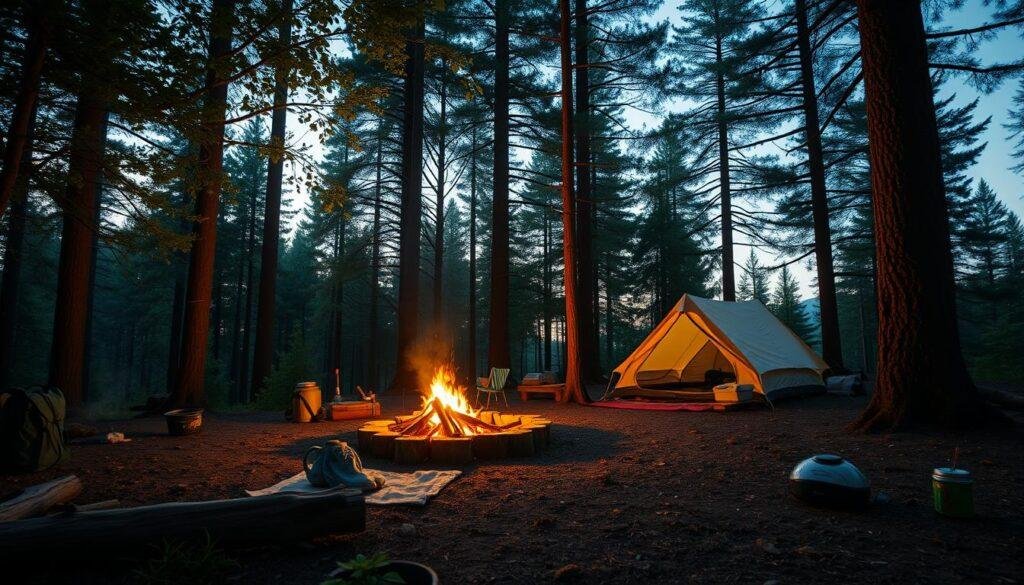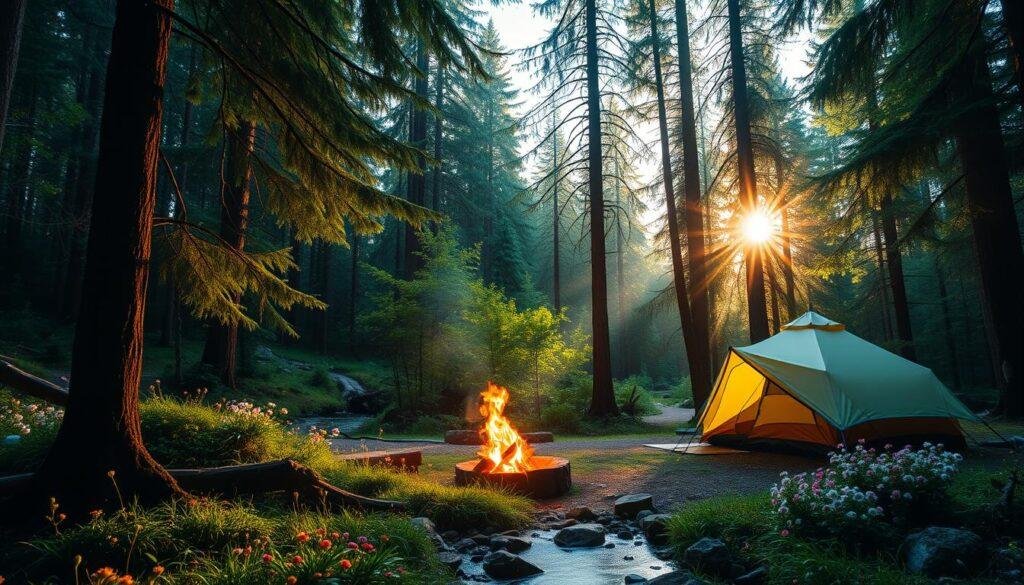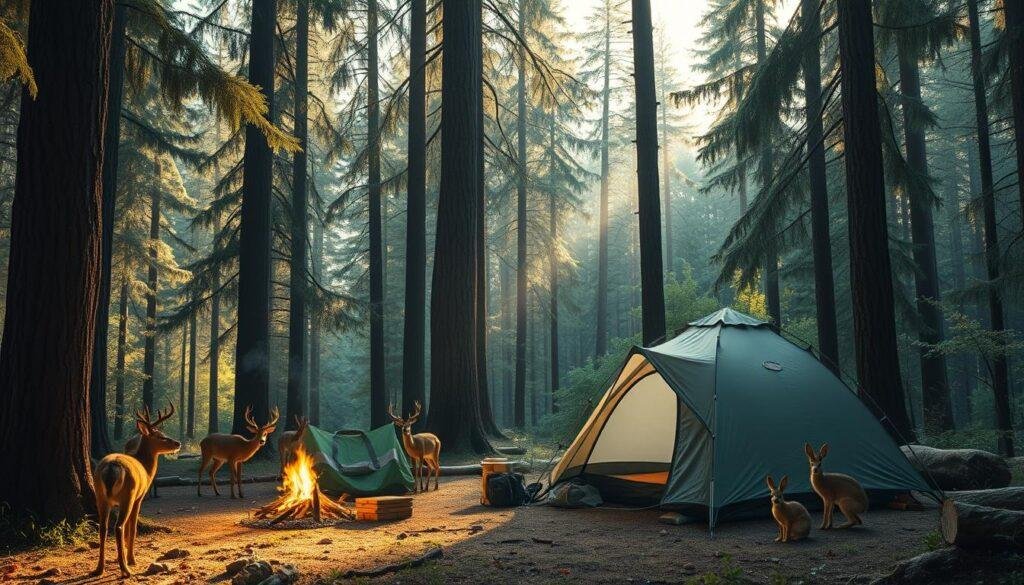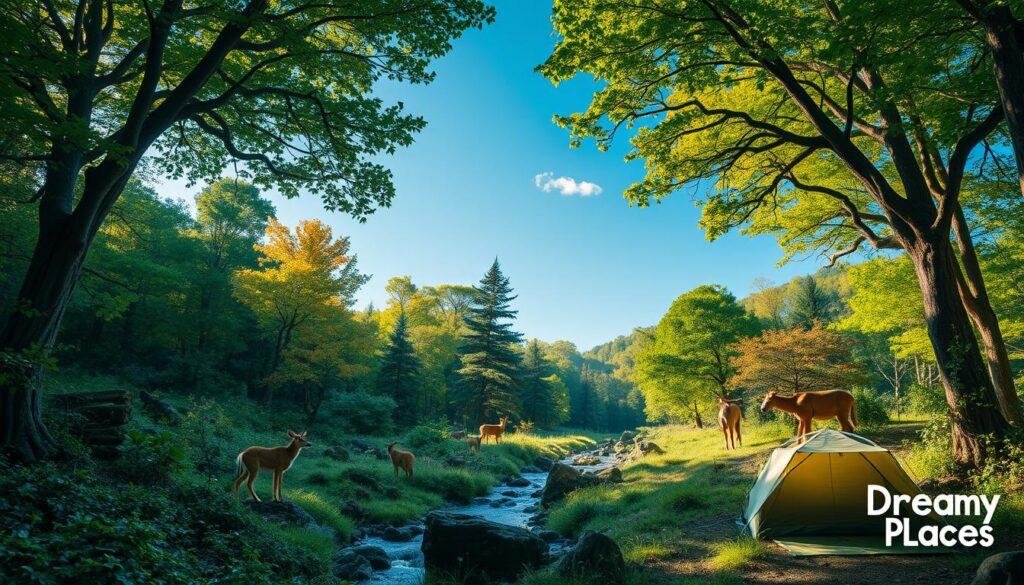Thinking about camping with the wild? You might wonder how to stay safe while enjoying nature. What makes a forest camping guide great? It’s about safe tips and keeping the wild wild. This way, your trip will be both exciting and safe.

Getting ready for your adventure means learning about forest camping. Safety and preparation are key. This guide will teach you how to camp safely and respect nature. You’ll learn the basics and how to keep the forest beautiful.
Key Takeaways
- Understanding the basics of forest camping is key for a safe and fun trip.
- Safe camping tips can prevent accidents and keep you safe in the wild.
- With the right gear and prep, your camping can be thrilling.
- A good forest camping guide offers valuable insights for a successful trip.
- Always prioritize wilderness camping safety when exploring the forest.
- Using eco-friendly practices helps keep the forest beautiful.
Essential Preparation for Camping with the Wild
Planning your forest camping trip? Make sure to focus on wilderness camping safety for a great time. Before you go, check the weather and pick the best season. Knowing the physical challenges and getting the right permits are also key steps.
Here are some important things to think about:
- Weather research: Look at the forecast and know about any weather dangers, like heavy rain or extreme heat.
- Season selection: Pick a season that fits your likes and skills, considering the weather and daylight.
- Physical conditioning: Check your fitness level, as forest camping can be tough.
- Permit and registration processes: Learn about the needed steps and get any required permits for a legal trip.
By following best practices for forest camping and getting the right gear, you’re set for a great trip. Always keep wilderness camping safety in mind and be ready for anything.
With good planning and attention to detail, you can have a safe and memorable forest camping trip. Stay tuned for more tips to enhance your forest camping adventures.
| Preparation Step | Importance Level |
|---|---|
| Weather research | High |
| Season selection | Medium |
| Physical conditioning | High |
| Permit and registration processes | Medium |
Choosing Your Perfect Forest Camping Location
When planning a forest camping trip, picking the right spot is key. You want a place that’s easy to get to, beautiful, and safe for wildlife. Start by looking up top camping spots and reading what other campers say.
Think about the season, weather, and wildlife in the area. This helps you plan a trip that fits your needs. For example, if you want peace and quiet, pick a less crowded spot during busy times.

Consider activities like hiking, fishing, and watching wildlife. Look for campsites with water, restrooms, and picnic tables. By doing your research, you can find the best spot for your next camping trip. This way, you’ll have a safe and fun time with wildlife in mind.
Top camping spots have lots of activities and amenities. They’re great for both new and seasoned campers. When planning a forest camping trip, check the local rules and follow best practices for wildlife safety during forest camping. This keeps the environment safe and ensures a good time for everyone.
Must-Have Gear for Forest Camping Success
Getting ready for a safe forest camping trip means having the right gear. It’s important to invest in quality equipment that keeps you comfy and safe. You’ll need a strong tent, a warm sleeping bag, and a camping stove that works well.
Here are some key items to make your trip safe and fun:
- Shelter and sleeping equipment, such as a tent and sleeping pad
- Food storage and cooking tools, including a camping stove and utensils
- Navigation and communication devices, such as a map and compass or a GPS device
- Emergency and first-aid supplies, including a first-aid kit and a whistle
With these essentials, you’re set for a great forest camping adventure. Enjoy the views and wildlife while keeping safety in mind. Always follow the rules and respect the environment. With the right gear and planning, your trip will be both safe and exciting.

Choosing the right gear is key for a great forest camping trip. Think about how many people are coming, how long you’ll stay, and the weather. With the right equipment and safety tips, your trip will be unforgettable.
| Equipment | Description |
|---|---|
| Shelter and sleeping equipment | Tent, sleeping bag, sleeping pad |
| Food storage and cooking tools | Camping stove, utensils, cooler |
| Navigation and communication devices | Map, compass, GPS device, whistle |
| Emergency and first-aid supplies | First-aid kit, flashlight, extra batteries |
Travel Forest 3: Your Ultimate Wildlife Safety Guide
When planning best forest locations for adventurous camping trips, safety is key. Travel forest teaches us to respect and safely live with wildlife. To avoid wildlife, pick safe spots, know animal behavior, and prepare well.
For a safe and fun forest camping trip, consider these tips:
- Learn about the area’s wildlife
- Keep your campsite clean and store food and trash right
- Make noise while hiking to not scare animals
- Stay alert and watch for wildlife signs
By following these tips, you can enjoy your best forest locations for adventurous camping trips safely. Always put safety guidelines for overnight stays in dense forests first. Travel forest 3 is about loving nature and keeping it safe for others.

With the right knowledge and care, forest camping can be safe and fun. Always respect wildlife and follow safety guidelines for overnight stays in dense forests for a great trip.
| Wildlife Safety Tips | Description |
|---|---|
| Keep a clean campsite | Store food and trash properly to avoid attracting wildlife |
| Make noise while hiking | Avoid surprising animals by making noise while hiking |
| Be aware of your surroundings | Watch for signs of wildlife and keep an eye out for possible dangers |
Setting Up Your Forest Campsite
Choosing the right campsite is key for a safe and fun camping trip in national forests. Look for spots close to water, on level ground, and protected from the weather. With some essential tips, you can have a comfortable and safe stay in the wilderness.
Finding a safe spot is critical. Avoid areas with loose rocks, steep slopes, and branches that could fall. Keep an eye out for wildlife signs like tracks or scat. Also, pick a spot for your tent that’s level, dry, and shields you from the wind.
Creating a Safe Food Storage Area
When camping in national forests, it’s important to follow safety rules to avoid attracting wildlife. Store food and trash right, use bear-resistant containers, and keep your campsite clean. These steps help you avoid wildlife encounters and ensure a safe camping trip. Some important tips include:
- Storing food and trash in airtight containers
- Keeping a clean campsite, free from food and trash
- Using bear-resistant containers to store food and trash

By following these guidelines and taking the right precautions, you can have a safe and memorable camping trip in national forests. Always prioritize safety and follow these tips to protect the environment and enjoy your trip.
Wilderness Survival Skills You Need to Know
When you head into the forest, knowing wilderness survival skills is key. It ensures a safe and fun trip. Knowing how to handle wildlife encounter precautions is very important. This means identifying dangers like wild animals and avoiding them.
Finding food and water is another critical skill. You can learn about edible plants, fishing, and eco-friendly camping practices. For example, using a water filter or purification tablets can get you clean drinking water.
Navigating the forest is also essential. You can use a map, compass, and GPS. Knowing how to start a fire is vital too. It gives you warmth, light, and a way to cook. Always be aware of your surroundings and take steps to avoid getting lost when travel forest 3.

- Find or create a shelter
- Start a fire without matches
- Identify edible plants and animals
- Navigate using natural signs
By learning these skills and following wildlife encounter precautions, you’ll be ready for anything. Your forest adventure will be safe and enjoyable.
Eco-Friendly Camping Practices
When you start your nature retreat, it’s key to travel in an eco-friendly way. This keeps the environment safe for now and for the future. Here are some tips to make your camping trip green.
Remember, leave no trace is a big part of eco-friendly camping. This means taking care of your waste, respecting animals, and using green gear. You can do this by:
- Using less single-use plastics
- Throwing away waste and recyclables right
- Choosing green camping tools, like solar lights and refillable water bottles
These steps help you leave the environment better than you found it. Every little bit helps, and together we can protect our natural world for more adventures.

While in the forest, take time to enjoy nature and think about sustainable travel. By picking green travel and acting eco-friendly, you support a fun and responsible nature retreat.
| Tip | Description |
|---|---|
| Plan ahead | Research the area, check the weather, and prepare to lessen your environmental impact. |
| Respect wildlife | Stay far away, don’t feed them, and never litter to protect animals and their homes. |
| Conserve resources | Use energy-saving gear, save water, and cut down on waste to reduce your ecological footprint. |
Weather Safety and Emergency Protocols
When planning a wilderness getaway, think about weather safety and emergency plans. Forest conservation helps keep ecosystems balanced. Being ready for sudden weather changes is key. By exploring green spaces carefully, you can enjoy your trip safely and protect nature.
Before you go, check the weather forecast for any dangers like flash floods or wildfires. Having a first aid kit and a way to call for help is also smart. These steps help protect the environment and make your wilderness getaway a success.
Here are some safety tips for your trip:
- Check the weather forecast often
- Bring a map and compass, and know how to use them
- Have a plan for emergencies
By following these tips, you can have a great andenvironmentally conscious vacation. You’ll also supportforest conservation efforts.

Always be prepared and take steps to ensure a safe trip. Exploring green spaces and caring for the environment helps preserve nature for the future.
“The best way to experience nature is to immerse yourself in it, while also being mindful of your impact on the environment.”
Conclusion: Embracing the Forest While Staying Safe
When you start your forest adventure, always remember to enjoy nature’s beauty. But, also keep your safety and the environment’s health in mind. The wilderness offers a chance to break free from daily life and connect with nature. It’s important to be ready and have the right mindset.
This guide will help you explore the forest safely and sustainably. You’ll learn how to enjoy the forest’s wonders without harming it. Let the peace of nature refresh your spirit as you travel responsibly.
Remember, the journey is as important as the destination. Take time to enjoy every moment and respect the ecosystem. With careful planning and a deep respect for nature, you’ll make unforgettable memories. And, you’ll help protect these beautiful places for future generations.
FAQ
What are the essential safety precautions I should take when forest camping?
When forest camping, it’s important to check the weather and seasons. Make sure you’re physically ready. Also, get the right permits and pack emergency supplies.
Learn about wildlife safety and eco-friendly camping. This will help you stay safe and enjoy nature.
How do I choose the best forest camping location for my trip?
Look for a spot that’s easy to get to and has beautiful views. Check if there’s wildlife and if you need a permit. Research the best places to camp in the forest.
Plan your trip well to find the perfect spot. It should meet your needs and preferences.
What kind of gear do I need for a successful forest camping adventure?
You’ll need good shelter and sleeping gear. Also, food storage, cooking tools, and ways to navigate and communicate. Don’t forget emergency and first-aid supplies.
Choosing the right gear makes your camping safer and more comfortable.
How can I minimize the risk of wildlife encounters during my forest camping trip?
The Travel Forest 3 concept helps you stay safe around wildlife. Choose safe spots to camp and understand animal behavior. Take steps to avoid dangerous encounters.
What are the key steps for setting up a safe and comfortable forest campsite?
Find the perfect spot for your campsite. Position your tent right and keep food safe. Follow wilderness survival tips and camping rules.
This ensures a safe and fun camping trip.
What wilderness survival skills do I need to know for a forest camping trip?
Learn to find food and water, start a fire, and navigate. Practice eco-friendly camping to respect nature. This way, you can enjoy your trip without harming the environment.
How can I ensure I camp in an eco-friendly and sustainable manner?
Follow the Leave No Trace principles and use sustainable camping methods. Respect wildlife and nature. This way, you can enjoy the forest while protecting it.
What weather safety precautions should I take, and what emergency protocols should I have in place?
Always watch the weather and have emergency plans ready. Learn about weather and emergency steps. This keeps you safe during your camping trip.
Also, focus on forest conservation and responsible camping. This makes your trip better and helps nature.



